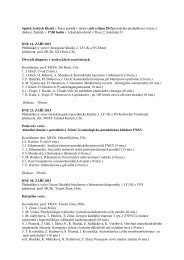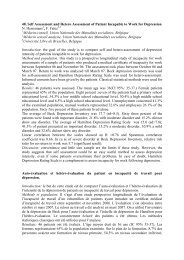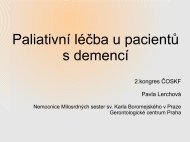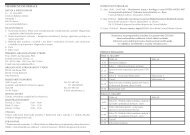ABSTRACTS â ORAL PRESENTATIONS - AMCA, spol. s r.o.
ABSTRACTS â ORAL PRESENTATIONS - AMCA, spol. s r.o.
ABSTRACTS â ORAL PRESENTATIONS - AMCA, spol. s r.o.
Create successful ePaper yourself
Turn your PDF publications into a flip-book with our unique Google optimized e-Paper software.
proteins activity in HT-29 colon cancer cells.<br />
We report here decreased level of protein BCRP and decrease activity after treatment<br />
with 50 nM HY and HP or AR under the dark conditions after 16 h treatment, while no<br />
significant changes of MRP1, MRP2 and P-gp were found. When evaluating HY alone or<br />
combination of HY with AR (6 h after light-activation) decreased level of protein MRP2<br />
was observed. The therapy with light-activated HY modulated by 5 μM HP showed<br />
increased level of protein MRP1 and MRP2, in contrast to the decreased level of BCRP<br />
and MRP2 protein after therapy HY or AR alone or HY/5μM AR. However the most<br />
important analysis was transporter proteins activity which show decreased.<br />
The cytochrome P450 3A4 (CYP3A4) is one of the most important enzymes involved in the<br />
metabolism of xenobiotics in the human body. The protein level of CYP3A4 was increased<br />
by HY, HP and AR therapy alone or in combination of HY/1μM HP. The subsequent analysis<br />
of CYP3A4 proteins and mRNA 6 h after light-activation of HY therapy modulated by AR<br />
showed significant decreased level of protein, similarly decreased of mRNA expression<br />
and decreased of protein activity. We may conclude that pre-treatment with HP or AR<br />
affected proteins level of BCRP, MRP1 and MRP2, what could be one of the mechanisms<br />
responsible for pharmacokinetics of hypericin in HT-29 colon adenocarcinoma cells<br />
leading to higher therapeutic efficiency of HY-PDT. The inhibitory effect of HP and AR to<br />
activity of membrane transport proteins and to CYP3A4 protein also could be important<br />
as therapeutic strategies in the treatment of cancer. The presented data may help to<br />
elucidate the mechanisms of action for various bioactive constituents of St. John’s wort<br />
possessing potential therapeutic properties.<br />
Acknowledgements<br />
This work was supported by the Slovak Research and Development Agency under the<br />
contract No. APVV-0040-10 and the Scientific Grant Agency of the Ministry of Education<br />
of the Slovak Republic under the contract No. VEGA 1/0626/11.<br />
References<br />
Agostinis, P., Assefa, Z., Vantieghem, A., Vandenheede, J.R., Merlevede, W., De Witte, P.:<br />
Apoptotic and anti-apoptotic signaling pathways induced by photodynamic therapy with<br />
hypericin. - Adv. Enzyme Regul. 40: 157–182, 2000.<br />
Erdelmeier, C.A.: Hyperforin possibly the major non-nitrogenous secondary metabolite<br />
of Hypericum perforatum L. – Pharmacopsychiatry 31: 2–6, 1998.<br />
Gartner M., T. Muller, J.C. Simon, A. Giannis, J.P. Sleeman, Aristoforin, a novel stable<br />
derivative of hyperforin, is a potent anticancer agent. - Chembiochem 6: 171–177, 2005.<br />
Semelakova, M., Mikes, J., Jendzelovsky, R. and Fedorocko, P.: The pro-apoptotic and<br />
anti- invasive effects of hypericin-mediated photodynamic therapy are enhanced by<br />
hyperforin or aristoforin in HT-29 colon adenocarcinoma cells. - Journal of Photochemistry<br />
and Photobiology B-Biology. 117: 115-125, 2012.<br />
Analytical Cytometry VII 127








